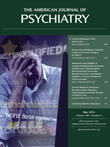Insights Into the Neural Mechanisms Underlying Delirium
In this issue, Choi et al. (1) examine resting-state functional connectivity of a priori determined regions of interest in patients with delirium. Using functional MRI (fMRI) scans from 22 delirium patients and 22 age- and sex-matched comparison subjects, the authors elucidate possible neural mechanisms underlying this disorder. The results showed a long-lasting disruption in reciprocity of the dorsolateral prefrontal cortex with the posterior cingulate cortex and a reversible reduction of functional connectivity of subcortical regions such as the thalamus with the retricular activating system and with nuclei responsible for forebrain acetylcholine and dopamine innervation.
Engel and Romano (2) first demonstrated cerebral insufficiency with EEG recordings, the most sensitive and reliable indicator available in 1959. Accumulating evidence suggests that anticholinergics increase the risk of delirium and that antidopaminergic drugs ameliorate symptoms. However, which brain regions are involved in these effects and the physiology of delirium's often fluctuating course remain unknown. Choi and colleagues' study attempts to answer these questions with current brain-imaging methods.
Their analyses of connectivity, developed from examining correlations of blood oxygen levels between various brain regions in resting-state fMRI scans, show that the brain in delirium patients has disrupted connectivity between the dorsal lateral prefrontal cortex and the posterior cingulate cortex. The authors suggest that the persistence of this physiological disruption beyond the resolution of acute delirious symptoms accounts for patients' problems in attentiveness that often outlast their acute hospitalization. A disruption of the connectivity of key subcortical regions, such as the intralaminar thalamus, from brainstem and midbrain nuclei was also observed. The disrupted connectivity includes the mesencephalic tegmentum, which relays brainstem reticular activation, the midbrain nucleus basalis, the source of cholinergic innervation, and the midbrain ventral tegmental area, the source of dopaminergic innervation. Unlike the cortical connections, these subcortical connections recover more quickly, perhaps because they reflect the transient effects of the anticholinergic drugs from anesthesia and the antidopaminergic drugs used for acute behavioral control. The resolution of connectivity between the mesencephalic tegmentum and the thalamus may account for the early restoration of alertness, although higher brain neocortical functions remain altered. Strengths of this study include the scanning of patients both during the acute episode and after its resolution; weaknesses include the a priori assumption about the role of the posterior cingulate cortex and the modest sample size. The patients' use of medication also confounds results but is clinically unavoidable.
Ethical Considerations
The diagnosis of delirium does not in itself establish incompetence, but some patients in this study were too ill to provide informed consent. Surrogate consent was used to provide substituted judgment. Although brain imaging is not a toxic procedure, it nonetheless must have been terrifying for some delirium patients. Their participation is consistent with the principle of using surrogate consent to allow medical researchers to learn potentially useful information about acute illness, including illnesses that attack mental capacity itself, even if there is no direct benefit to the patient who is being studied (3). The Choi et al. study is consistent with this principle and, like many such studies, may benefit future patients through the development and monitoring of new treatment effectiveness.
Intense efforts to prevent delirium in postoperative patients and in critical care populations have been made (4), but we still possess few insights into delirium's pathophysiology. It also appears that delirium treatment studies are less appealing to researchers and funding organizations. In fact, in 2012, there is only a single randomized controlled trial of pharmacological delirium treatment from 1996 (5). Significant improvements could thus be made in the field of delirium pathophysiology.
1. : Neural network functional connectivity during and after an episode of delirium. Am J Psychiatry 2012; 169:498–507Link, Google Scholar
2. : Delirium, a syndrome of cerebral insufficiency. J Chronic Dis 1959; 9:260–277Crossref, Medline, Google Scholar
3. : The informed consent process in older patients who developed delirium: a clinical epidemiologic study. Am J Med 1997; 103:410–418Crossref, Medline, Google Scholar
4. : Fast, systematic, and continuous delirium assessment in hospitalized patients: the nursing delirium screening scale. J Pain Symptom Manage 2005; 29:368–375Crossref, Medline, Google Scholar
5. : A double-blind trial of haloperidol, chlorpromazine, and lorazepam in the treatment of delirium in hospitalized AIDS patients. Am J Psychiatry 1996; 153:231–237Link, Google Scholar



